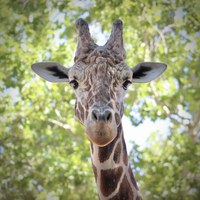ABQ BioPark gives “gold star” treatment in the golden years
This month, Buccaneer the giraffe celebrated his twenty-first birthday. This well exceeds the median life expectancy of 15 years for male giraffes. Aging is inevitable, and the ABQ BioPark's animals are no exception. But here, the aging population has a team of expert staff dedicated to spoiling them with specialized meal plans, physical therapy, social opportunities and enrichment activities that keep their brains and bodies active. Animals that live under our care generally outlive their wild counterparts due to complete and quality-controlled diets, lack of natural predators, and preventative veterinary care throughout their lives.
As animals grow older, they face issues and ailments similar to those experienced by humans. These ailments may include vision and hearing loss, degenerative joint disease/arthritis, dental issues and loss of strength and balance, among others.
To counter these conditions, the ABQ BioPark provides the animals in our care with specialized options. They may receive extra bedding so that they’re as comfortable as possible, and animal care teams make changes to their diet to ensure they receive different nutrients and vitamins based on individual needs, or softer food that is easier to chew. As an animal’s mobility changes, they may need habitat alterations like smoother terrain or lowered perches. The ABQ BioPark administers joint supplements to any animals that are suspected to suffer from aging-related joint cartilage erosion. Such supplements can slow the progression of degenerative joint disease, but do not reverse the condition.
In addition to Bucc, the ABQ BioPark currently also has three female reticulated giraffes. Matriarch female June will be 30 this summer. This means that both of them experience those age-related health changes and receive catered care to maintain the maximum quality of life possible.
June is one of the oldest giraffes in any zoo in the United States, and Bucc is among the oldest males. Both of them have arthritis in their front limbs and are treated with pain management medications and supplements daily. The giraffe animal care team has created large, soft piles of sand or aspen shavings throughout the exhibit and inside the giraffe barn. This helps relieve pressure on their joints when they lie down at night. Sometimes June still folds her head on her rump like baby giraffes do! The care team added rubber mats for additional cushioning in areas where they spend a lot of time standing to eat, just like those used for human ergonomics. They are also offered hay bags, browse, and puzzle feeders at escalating heights to encourage them to use a natural "reaching" posture when they eat, instead of bending down or slouching.
Bucc and June are invited to participate in several training sessions per week to work on behaviors that help with voluntary medical procedures like taking blood samples, giving injections, vaccinations, voluntary x-rays, and hoof trims. X-rays provide a detailed look at how arthritis changes over time, so that treatment can be adjusted as needed. Hoof maintenance is an integral part of skeletal alignment and mobility in hooved species, and routine blood samples allow the veterinary staff to track changes in health over time. The long-term relationships between our senior animals and their care team allows the BioPark to provide this important healthcare while reducing the animals’ stress and the need for anesthesia. If an animal declines care that isn’t critical, the staff respects their choice. This creates a foundation of trust and cooperation, to ensure that senior animals can continue thriving as long as possible.

